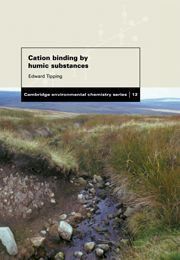Book contents
- Frontmatter
- Contents
- Preface
- 1 Introduction
- 2 Humic substances – a brief review
- 3 Environmental solution and surface chemistry
- 4 Proton dissociation from weak acids
- 5 Metal–ligand interactions
- 6 Methods for measuring cation binding by humic substances
- 7 Quantitative results with isolated humic substances
- 8 Cation binding sites in humic substances
- 9 Parameterised models of cation–humic interactions
- 10 Applications of comprehensive parameterised models
- 11 Predictive modelling
- 12 Cation–humic binding and other physico-chemical processes
- 13 Cation binding by humic substances in natural waters
- 14 Cation binding by humic substances in soils and sediments
- 15 Research needs
- References
- Index
15 - Research needs
Published online by Cambridge University Press: 18 August 2009
- Frontmatter
- Contents
- Preface
- 1 Introduction
- 2 Humic substances – a brief review
- 3 Environmental solution and surface chemistry
- 4 Proton dissociation from weak acids
- 5 Metal–ligand interactions
- 6 Methods for measuring cation binding by humic substances
- 7 Quantitative results with isolated humic substances
- 8 Cation binding sites in humic substances
- 9 Parameterised models of cation–humic interactions
- 10 Applications of comprehensive parameterised models
- 11 Predictive modelling
- 12 Cation–humic binding and other physico-chemical processes
- 13 Cation binding by humic substances in natural waters
- 14 Cation binding by humic substances in soils and sediments
- 15 Research needs
- References
- Index
Summary
In this closing chapter, ways are suggested to advance knowledge about cation–humic interactions, and to apply that knowledge more widely. Laboratory measurements on isolated materials are discussed, then field measurements, and finally modelling at the ecosystem level.
Research needs for isolated humic materials
The material covered in Chapters 7–11 demonstrates that much work has been done on humic substances and their interactions with cations. Many cations have been studied, and a substantial body of knowledge has been built up. Furthermore, there have been many studies of the chemical structures and physico-chemical properties of humic substances. Of course, any new information on humic substances is potentially valuable in improving our understanding and ability to predict cation–humic interactions, but several key areas can be identified. Work with isolated materials under well-defined conditions is essential to understand the details of the reactions.
Isolation of humic matter
The understanding and prediction of cation binding by isolated humic substances is a step on the way to describing how cations interact with organic matter in the natural environment. We would be foolish to ignore the available information on isolated humic and fulvic acids, but the information is valuable only if it can be used to describe the real world. Therefore we have to take account of whether the isolated materials are (a) significantly unaltered from their natural states, apart from being freed of ‘contaminating’ entities, and (b) are sufficiently representative of natural organic matter as a whole.
Information
- Type
- Chapter
- Information
- Cation Binding by Humic Substances , pp. 380 - 390Publisher: Cambridge University PressPrint publication year: 2002
